The Origins of a Nation 英国的民族起源
- 格式:ppt
- 大小:3.55 MB
- 文档页数:23
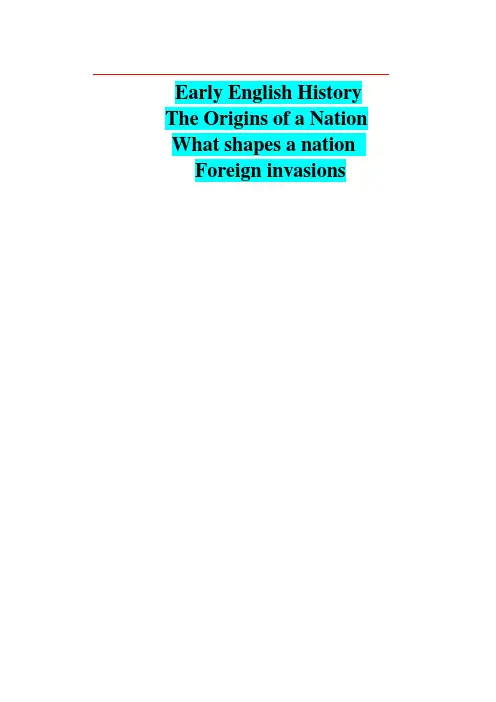
Early English History The Origins of a Nation What shapes a nation Foreign invasionsBritain is better remembered for its past, or its longhistory, and the British history has been a history of invasions.When we talk about British people, we should be clear about the origin of them.The forefathers of British people had different national origins.A.I berians (伊比利亚人)The first known settlers of British people were Iberians. They came to Britain at about 3,000 BC during the New Stone Age. They probably came from the Iberian peninsular, now Spain. They are a dark-haired Mediterranean race. They are short in height, dark in skin and long in head. They were farming folk who kept animals and grew crops.B . Celts (凯尔特人)By the end of the Bronze Age, around 700 BC Celtic people had arrived from northwestern Europe, now France, Belgium and southern Germany. Celts are tall in height, blond in hair and somewhat aggressive. Their language was called the Celtic language. When they came, they brought with them a revolutionary new skill: iron-working. Celtscontinued to come and settle in Britain for about 500 years. They di dn’t kill off the Iberians. They drove some of them to the north and west, kept the rest as slaves and in the end the two races mixed to varying extent in different parts of the country. The Celtic tribes are ancestors of the Highland Scots, the Irish and the Welsh, and their languages are the basis of both Welsh and Gaelic.C. RomansBritish recorded history begins with the Roman invasion.In 55BC, Julius Caesar, the great Roman general, invaded Britain for the first time. He landed in Kent with several thousand men. He met resistance and bad weather, so he decided to withdraw. He returned the following year. Yet, the successful invasion did not take place until nearly a century later, in AD 43, headed by the Emperor Claudius.So at last Romans came. When they came, they brought with them their laws, taxes, engineering skills, architecture and social system as well as theirlanguage, Latin. They also brought the new religion, Christianity, to Britain. Christianity came at first by indirect means, probably brought by traders and soldiers, and was quite well established later.The Romans made good use of Britain’s natural resources, mining lead, iron and tin锡and manufacturing pottery陶器. Though, the Romans gave the Britons a good deal of their civilization, they never settled in Britain in large numbers. They departed in AD411. They left behind a well-established Celtic-Roman culture. They also left behind the first written description of the land and its peoples.Reasons for withdraw in AD 410:a. barbarians from Eastern Europe at the gates of Rome;b. repeated attacks from Picts, so called because of their “painted faces”蓝军, and Scots;Ways to keep Picts: They built two great walls to keep the Picts out of the area they had conquered. These were Hadrian’s Wall and Antonine Wall.c. needing to set up a new military front on the east coast to hold off the Germanic Saxon tribes invading from Europe.D. Anglo-Saxons (盎格鲁-撒克逊人)In the 5th century AD, groups of people from North Europe came to settle in England. They were the Angles, Saxons and Jutes. These Germanic peoples form the basis of the modern English race. Theybrought in Old English, which was to become the official language of the nation. From AD 450 to 600, they gradually took control of most of the country. They became Christians and settled down as farmers. The name England is in fact derived from Anglo-land. The “Eng-”part comes from the word Angles. The word “English” means “ the language that belongs to the Angles.” Because “-ish” means “belonging to.” 1.Anglo-Saxons and the found of Heptarchy The Anglo-Saxons were three tribes of the Germanic people who originally lived in the northwest of modern Germany. In the mid-5th century a new wave of invaders, Jutes, Saxons, and Angles came to Britain. They were three Teutonic tribes.The leader of Jutes, Hengist, became the King of Kent in 449.Then the Saxons established their kingdoms in Essex, Sussex and Wessex from the end of 5th century to the beginning of the 6th century.The Angles settled in East Anglia, Mercia and Northumbria. These seven principal kingdoms ofKent, Essex, Sussex, Wessex, East Anglia, Mercia and Northumbria have been given the name of Heptarchy.2.In 829, Egbert, King of Wessex, became an overlord of all the English.King Arthur was the ruler of England in the 6th century. According to legendary stories, Arthur was the bastard私生子of the king of England. After the king died, Arthur was brought up secretly by an ordinary man. When he grew up, he got from the stone successfully the supernatural sword (神剑). This he was made sure the king of England.Many people know the story of King Arthur and his Knights of the Round Table. According to the story, Arthur’s knights were often arguing about the seats while having meetings. Arthur was annoyed, then he ordered his men to have the big round table as the table for meetings. In this way, there would be no difference between the seats, and there would be no arguments over the seats. Maybe that’s the origin of round tables for meetings.King Arthur’s Round TableIn Arthurian legend, based on stories about the Anglo-Saxon hero King Arthur, the Round Table at Camelot served as a gathering place for Arthur’s knights. The table’s shape ensured that all who sat around it were equals. This replica of the Round Table can be seen at Winchester Castle in England.E.D anesNext came the Viking raiders (维金人/北欧海盗) from Scandinavia and Danes from Denmark. They attacked various parts of England from the end of the 8th century. They became a serious problem in the 9th century. They even managed to capture York, an important center of Christianity in 847. They plundered掠夺the coastlands and islands but eventually, they too settled, intermarried通婚andfused with the local population. During the 9th and 10th centuries, England was divided almost in half between the Viking Danes in the east and northeast and the Saxons in the west. By the end of the 10th century, however, the Saxons controlled most of the country. (Alfred the Great defeated the Danes and came to a relatively friendly agreement with them in 879.)Alfred was born in 849 at Oxfordshire and died in 901. He was one of the earliest and greatest of English Kings. He was also a pillar of light灯塔in the Dark Ages.The Dark Ages is a period of time in European history from 5th to the 11th centuries (黑暗时代). It is called the Dark Ages because this period of time was lacking in cultural achievements while ignorance and harsh despotism暴政became the ruling force.Alfred was the Saxon King. In 835, Danes began to come to England. The year 835 was the time before Alfred was born. So when Alfred became the King in 871 AD. The Danes were already in England in large numbers. They were threatening to take over England.Situation was bad for Alfred. Yet, he began to lead his men to fight against the Danes bravely. He reorganized the land army. At the same time, he built boats to fight against the Danes on the sea and rivers. Thus, he got the name of “the Fath er of the British Navy.”Of course, it was not easy for Alfred and his men to defeat the Danes, for the Danes were already very strong at the time. In the spring of 878, Alfred was defeated and compelled to flee逃跑for refuge.Many people know the story of “Alfred and the Burnt Cake” (烧焦的饼子). It’s said that once Alfred was surrounded by the Danes when he was in a farmhouse in the Danes’ occupied area. To hide from the Danes, the hostess of the house asked him to bake the cake. Alfred was so busy thinking of the ways of defeating the invading Danes that he let the cakes burn. Just at this time, the Danes came into the house in searching of Alfred. The hostess was a clever lady. She was pretending to scold Alfred for his burning of the cakes. In this way, he was not recognized by the Danes. Two months later, Alfred came out of his hiding place and organized his army again and beganhis plan for a counter attack反击. He finally defeated the Danes. But he was not able to drive the Danes out of the country. He made a treaty协议with them, allowing them to keep the northern and eastern parts of England.Alfred liberated half of England. Yet, he still worried about the Danes. He began to build the system of defense. Thus, he was regarded as an outstanding military leader in the British history.However, King Alfred did great contributions in peace.1) He established many schools.2) He took the lead to learn Latin.3) He repaired the churches and monasteries.4) He did translations and writings, which have been called the beginning of literature in England.Anglo-Saxon chronicleAlfred died in 901. After his death, more Danes came to England, because the later kings were not very strong. At last, a Danish King was put on the throne王冠. Yet, this Danish king didn’t rule long, and so didn’t his two sons. After their death, therewas no other man of the Danish royal family suitable for the throne. So, in 1042, Edward,an Englishman became the king. Edward ruled over England for 24 years. His main contribution as a king was the building of Westminster Abbey.Westminster Abbey was founded in 1065, one year before the death of Edward. From the 11th century to the 16th century, the palace was the reigning king’s place of residence. After the middle of the 16th century the king stopped to live at Westminster. Westminster is famous for its Poets’ Corner, which has been the traditional burial groundof the most famous English poets. Moreover, it is a place of coronation加冕for all the kings and queens since the Norman Conquest.F.Norman ConquestIn 1066, William of Normandy (William the conqueror) landed with a large armed force on the south coast and won a great victory over the Saxons (in the Battle of Hasting). William the conqueror and his followers set up a strong central government. This brought a new unified discipline and control to the country. They made French the official language and firmly established the feudal system封建体制. The king granted land to the aristocracy贵族. The French influence was so strong that many aspects of England’s social and cultural life became totally French.The Norman Conquest was the last invasion of England by foreigners.A) Norman ConquestThen in 1066, Edward died. Upon his deathbed, he recommended Harold as his successor继承人.Harold was Edward’s wife’s brother. He was also a great warrior. Yet, he was not from the royal family. He was accepted as king only upon Edward’s recommendation. So this gave rise to great dispute. William, Edward’s cousin表兄, was then Duke of Normandy. He was very angry when he heard the news that Harold became the king of England. He thought he should be the successor as the king of England. And this led to the Norman Conquest.Harold knew that William would come to measure swords 比剑with him. He was prepared to fight, placing an army on the southern coast of England to watch for William’s coming. Several months passed by and William failed to appear. When the harvest ti me in England came, many of Harold’s soldiers went back to their homes to gather in the crops. The coast was thus left undefended.William seized the chance and landed his army in Southeastern England without opposition in September 1066. Harold, who was fighting in the north, hurried back with his men. The two armies met near Hastings in Southeastern England. TheNormans, armed with bows and arrows, defeated the Anglo-Saxons who fought with battle-axes斧子. Harold was killed. This is the famous Battle of Hastings in English history.But the Normans were not so strong as to storm London directly. They crossed the Thames River and established their camps扎营a few miles from the city, cutting its connection with the hinterland(腹地). Finally, London was forced to give in and a big group of noblemen and churchmen came out of the city to welcome William. So on Christmas Day, 1066, Duke William was crowned in Westminster Abbey.William I of EnglandWilliam I, known as William the Conqueror, was king of England from 1066 to 1087. As king, William reorganized the feudal system, making all landholders swear greater loyalty to him rather than to theirseparate lords. William also ordered an exhaustive survey of the landed wealth in his realm. The written results, known as the Domesday Book, helped determine the revenues owed him by his subjects.After William was crowned the king of England (William I), the Norman aristocracy began to rule over a largely Saxon and English-speaking population. And this produces another of England’s heroic legends, the legend of Robin Hood.Robin Hood is a legendary hero of medieval中世纪England. In most tales about him, Robin Hood leads an outlaw band called the Merry Men in brave forest adventures. The Merry Men fight authority当权政府and rob the rich to give to the poor. For more than 600 years, the adventures of Robin Hood have been celebrated in stories, poems, ballads民谣, and motion pictures.The stories of Robin Hood are typically set in England between the 1100s and the 1400s. Most of the events take place in or near Sherwood Forest. The stories about Robin celebrate his courage, generosityand skill in archery (剑术). He does not hesitate to fight and steal from his enemies, but he always shows compassion (同情) for the poor, protects women and children, and offers assistance to anyone of honor.Although Robin fights to overturn the power of rich landowners, church leaders, and government representatives, he and his band respect the authority of the ruling king, who in most stories is Richard I. In many stories, the king disguises 乔装himself and joins the Merry Men, intending to capture Robin. But the king then discovers Robin’s honorable ways and pardons him.A number of prominent authors wrote about Robin Hood in the 18th and 19th centuries, including Sir Walter Scott and John Keats. In England during the Victorian Age (1837-1901), the legend became a popular inspiration for children's tales.Robin HoodThe legendary hero Robin Hood is a popular figure from English folklore. According to the stories about him, he led a band of outlaws called the Merry Men, who robbed from the rich to give to the poor.Statue of Robin HoodEnglish ballads tell the story of the outlaw Robin Hood, who lived in England’s Sherwood Forest. No one knows for sure if Robin Hood existed, but the ballads about him give valuable information about English society in the late 14th and early 15th century.B) Influence of the Norman ConquestThe Norman Conquest was the last invasion of England by foreigners. Since then, no foreign invaders have ever set foot on this country. The Norman Conquest sped up the development offeudalism封建主义in England. The development of feudal aristocracy resulted in the appearance of noble titles. What’s more, the Norman way of life, French civilization imposed itself on the English people. And one of the most striking manifestations(证明) of the great influence of the conquerors was naturally to be seen in the language. The Norman continued to speak French for about three centuries after their conquest of England while their English subjects(仆人)retained their English tongue, which had developed into “Middle English”. The period of Middle English began soon after 1066. The Normans and the Anglo-Saxons,however, gradually got mixed and became intermingled融合.Exercises:1.Who are said to be the first forefathers of British people? (Iberians)2.When Celts went to Britain, they brought with them a revolutionary new skill. What is it? (iron working)3.Who introduced Christianity to Britain? (Romans)4.Who introduced Latin to Britain? (Romans)5.Who formed the basis of the Modern English race? (Angles, Saxons and Jutes) The Origins of a Nation(5000 BC -1066)Ⅰ.Settlers (5000 BC –55 BC)1.Iberians (the first known settlers)①At about 3000 BC, these short, dark and long-headed people came to Britain, probablyfrom the Iberian Peninsula, now Spain.②Long barrows in Wiltshire and Dorset were their communal burial mounds.③Stonehenge in Wiltshire is more dramatic monuments, which may have religious andpolitical means.2.Beaker Folk①At about 2000 BC they come from the areas now known as Holland and the Rhineland.②They took the name from their bell-shaped drinking vessels with which they wereburied in crouching positions in individual graves.③They built hill forts, with the finest examples of Maiden Castle.3.Celts①A taller and fairer race began to arrive about 700 BC.②They may originally come from eastern and central Europe, now France, Belgium andsouthern Germany.③They came in three main waves: a. Gaels at 600 BC (Gaelic); b. Brythons at 400 BC; c.Belgae at 150 BC (industrious and vigorous).④The Celtic bribes are ancestors of Highland Scots, the Irish and the Welsh, and theirlanguages are the basis of both Welsh and Gaelic.⑤The Celts’ religion was Druidism (human sacrifices). The Druids were the wise men,astrologers and soothsayers.Ⅱ.Roman Britain (55BC-410AD)1.Roman ConquestBritish recorded history begins with the Roman invasion. Julius Caesar, invaded Britain for the first time in 55BC. He returned the following year, but he didn’t succeed. The successful invasion was take place in AD43, headed by the Emperor Claudius.2.Reasons for untotal occupation: a. some parts of the country resist; b. Roman troops wereoften withdraw from Britain to fight in other parts of Roman Empire.3.Ways to keep Picts: They built two great walls to keep the Picts, so called because of their“painted faces”, out of the area they had conquered. These were Hadrian’s Wall and Antonine Wall.4.Three problemsa.Picts still attacked them periodically;b.Saxon pirates attacked them in the southeast;c.Control was only effective in the south-eastern part of the country.5.Achievementwork of towns and roads.①Caster and Chester means camp.②Capital: London (Londinium).③Two cities: York had been created as a northern stronghold; Bath rapidlydeveloped because of its waters.b.Make use of Britain’s natural resou rces, mining lead, iron and tin and manufacturingpottery.6.Religion: Christianity.7.Reasons for withdraw in AD 410: a. barbarians from Eastern Europe at the gates of Rome;b. repeated attacks from Picts and Scots;c. needing to set up a new military front on theeast coast to hold off the Germanic Saxon tribes invading from Europe.8.Why was the Roman influence on Britain so limited?The Romans always treated the Britons as a subject people of slave class. Never during the4 centuries did the Romans and Britons intermarry. The Romans had no impact on thelanguage or culture of ordinary Britons.Ⅲ.Anglo-Saxons (446-871)1.Anglo-Saxons and the found of HeptarchyThe Anglo-Saxons were three tribes of the Germanic people who originally lived in the northwest of modern Germany. In the mid-5th century a new wave of invaders, Jutes, Saxons, and Angles came to Britain. They were three Teutonic tribes. The leader of Jutes, Hengist, became the King of Kent in 449. Then the Saxons established their kingdoms in Essex, Sussex and Wessex from the end of 5th century to the beginning of the 6th century.The Angles settled in East Anglia, Mercia and Northumbria. These seven principalkingdoms of Kent, Essex, Sussex, Wessex, East Anglia, Mercia and Northumbria have been given the name of Heptarchy.2.Wars among Heptarchya.Offa, King of Mercia, built the great earthwork known as Offa’s Dyke, control for along time virtually all central, eastern and south-eastern England.b.In 829, Egbert, King of Wessex, became an overlord of all the English.3.Religiona.Teutonic religion (The names Tuesday, Wednesday, Thursday and Friday derive fromtheir gods)b.Christianity①Columba, 563, convert north commoner.②In 597, Pope GregoryⅠsent St. Augustine, the Prior of St. Andrew’s Monasteryin Rome, to England to convert the heathen English to Christianity. In 597, St.Augustine became the first Archbishop of Canterbury. Augustine was remarkablysuccessful in converting the king and the nobility, but the conversion of thecommon people was largely due to the missionary activities of the monks in thenorth.c.Disagreement: The Roman missionaries held that the Pope’s authority was supreme,and the Celtic missionaries held that Christian belief did not require a final earthlyarbiter. They held a conference at Whitby in 664. Finally, the Roman missionariesgained the upper hand.4.AchievementsThe Anglo-Saxons laid the foundations of the English state. They divided the country into shires. They devised the narrow-strip, three-field farming system. They also established the manorial system. And they created the Witan.5.QuestionsⅣ.Viking and Danish1.The Norwegian Vikings and the Danes from Denmark attacked various parts of Englandfrom the end of the 8th century. They became a serious problem in the 9th century, especially between 835 and 878. The Vikings and the Danes were posing a threat to the Saxon kingdom.2.Alfred, king of Wessex was strong enough to defeat the Danes and came to a relativelyfriendly agreement with them in 879.a.Danes gained control of north and east of E ngland, i.e. “the Danelaw”.b.Alfred, king of Wessex, rule the rest.3.Alfred’s achievements.Alfred, king of Wessex, is known as “the father of the British navy” as he founded a strong fleet which first beat the Danes at sea, then protected the coasts and encouraged trade. He also reorganized the fyrd (the Saxon army), making it more efficient. Alfred, who is said to have taught himself Latin at the age of 40, translated into English Bede’s Ecclesiastical history of the English People. A learned man himself, he encouraged learning in others, established schools and formulated a legal system. This, as well as his admirable work with the army and the navy, makes him worthy of his title “Alfred the Great”.4.Successors.a.King Ethelred the Unready tried paying the invaders, who renewed invasions becausethe successors reconquered the Danelaw, to stay away by imposing a tax, called thedanegeld, on his people.b.Canute, the Danish leader, was chosen by Witan as king. He made England part ofScandinavian empire which included Norway as well as Denmark.Ⅴ.The Norman Conquest (1066)1.Background: King is also said to have promised the English throne to William, Duke ofNormandy. But, when Edward was on his deathbed, four men laid claim to the English throne. Finally, the Witan chose Harold as king. Four men: King of Norway / Tostig ←→Harold (king) →Duke of Normandy( join together ) ( fight ) ( fight )2.Process: ①1066.10.14, the battle on Senlac Field (near Hastings), where Harold waskilled; ②1066 Christmas, William crowned King of England by the Archbishop of York.3.Measure to face Saxon risings in the north: “harrying of the north”.Significance: The Norman Conquest of 1066 is perhaps the best-known event in English history. William the Conqueror confiscated almost all the land and gave it to his Norman followers. He replaced the weak Saxon rule with a strong Norman government. So the feudal system was completely established in England. Relations with the Continent were opened, and civilization and commerce were extended. Norman-French culture, language, manners, and architecture were introduced. The Church was brought into closer connection with Rome, and the church courts were separated from the civil courts.。
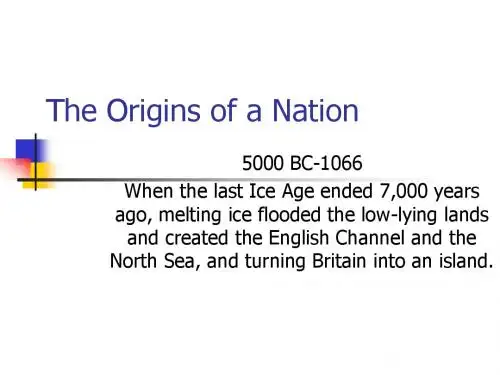
![英美概况笔记(中英文对照整理版)[1]](https://uimg.taocdn.com/497d6ac0102de2bd96058871.webp)
英美国家概论路人整理2011-7-27目录第一章英国的国土与人民LAND AND PEOPLE (3)第二章英国的起源THE ORIGINS OF A NATION (9)第三章英国的形成THE SHAPING OF THE NATION (16)第四章向现代英国的过渡TRANSITION TO THE MODERN AGE (22)第五章大英帝国的兴衰THE RISE AND FALL OF THE BRITISH EMPIRE (28)第六章英国经济THE ECONOMY (40)第八章法律与司法机构JUSTICE AND THE LAW (49)第九章英国社会SOCIAL AFFAIRS (55)第十章体育运动SPORTS (60)第十三章美国地理位置GEOGRAPHY (66)第十四章美国人口种族POPULATION.RACE AND ETHNIC GROUPS (70)第十五章美国历史(一)AMERICAN HISTORY(I) (73)第十六章美国历史(二)AMERICAN HISTORY(II) (77)第十七章美国历史(三)AMERICAN HISTORY(III) (81)第十八章美国经济THE ECONOMY (84)第十九章政治制度POLITICAL INSTITUTION (88)第二十章美国教育EDUCATION (93)第二十一章文化建筑和音乐LITERATURE, ARCHITECTURE AND MUSIC (98)第二十二章节日和假期HOLIDAYS AND FESTIVALS (102)第二十二章节:HOLIDAYS AND FESTIVALS 节日和假期 (102)第一章英国的国土与人民Land and PeopleI. Different Names for Britain and its Parts英国的不同名称及其各组成部分1.Geographical names: the British Isles, Great Britain and England.地理名称:不列颠群岛,大不列颠和英格兰。
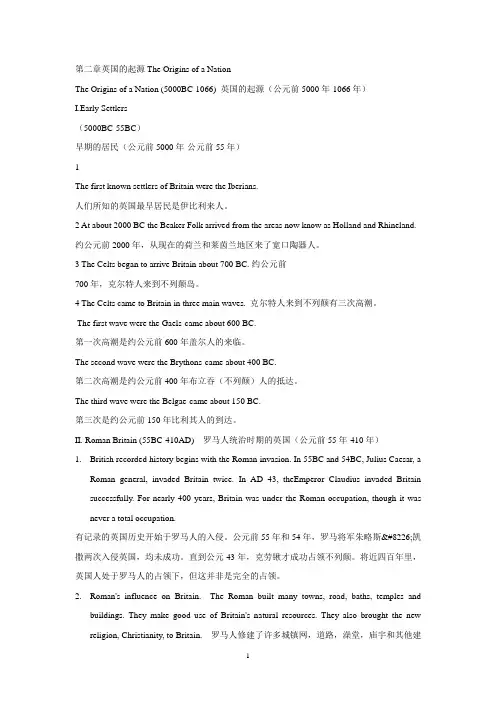
第二章英国的起源The Origins of a NationThe Origins of a Nation (5000BC-1066) 英国的起源(公元前5000年-1066年)I.Early Settlers(5000BC-55BC)早期的居民(公元前5000年-公元前55年)1The first known settlers of Britain were the Iberians.人们所知的英国最早居民是伊比利来人。
2 At about 2000 BC the Beaker Folk arrived from the areas now know as Holland and Rhineland. 约公元前2000年,从现在的荷兰和莱茵兰地区来了宽口陶器人。
3 The Celts began to arrive Britain about 700 BC. 约公元前700年,克尔特人来到不列颠岛。
4 The Celts came to Britain in three main waves. 克尔特人来到不列颠有三次高潮。
The first wave were the Gaels-came about 600 BC.第一次高潮是约公元前600年盖尔人的来临。
The second wave were the Brythons-came about 400 BC.第二次高潮是约公元前400年布立吞(不列颠)人的抵达。
The third wave were the Belgae-came about 150 BC.第三次是约公元前150年比利其人的到达。
II. Roman Britain (55BC-410AD) 罗马人统治时期的英国(公元前55年-410年)1.British recorded history begins with the Roman invasion. In 55BC and 54BC, Julius Caesar, aRoman general, invaded Britain twice. In AD 43, theEmperor Claudius invaded Britain successfully. For nearly 400 years, Britain was under the Roman occupation, though it was never a total occupation.有记录的英国历史开始于罗马人的入侵。
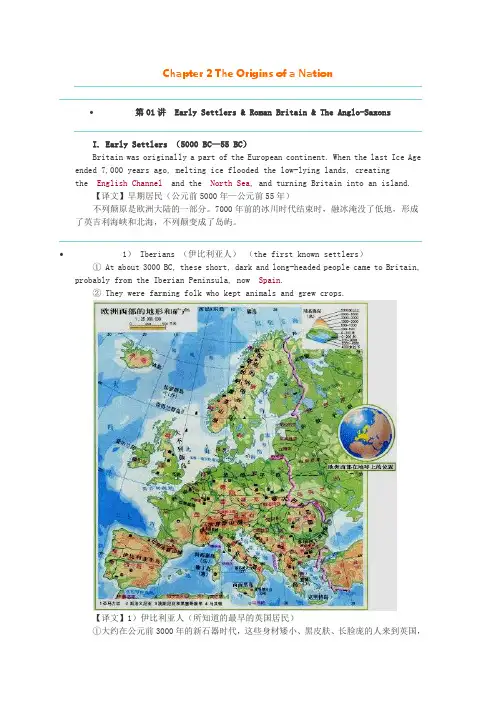
Chapter 2 The Origins of a Nation∙第01讲Early Settlers & Roman Britain & The Anglo-SaxonsI. Early Settlers (5000 BC—55 BC)Britain was originally a part of the European continent. When the last Ice Age ended 7,000 years ago, melting ice flooded the low-lying lands, creatingthe English Channel and the North Sea, and turning Britain into an island.【译文】早期居民(公元前5000年—公元前55年)不列颠原是欧洲大陆的一部分。
7000年前的冰川时代结束时,融冰淹没了低地,形成了英吉利海峡和北海,不列颠变成了岛屿。
∙1) Iberians (伊比利亚人)(the first known settlers)① At about 3000 BC, these short, dark and long-headed people came to Britain,probably from the Iberian Peninsula, now Spain.② They were farming folk who kept animals and grew crops.【译文】1)伊比利亚人(所知道的最早的英国居民)①大约在公元前3000年的新石器时代,这些身材矮小、黑皮肤、长脸庞的人来到英国,他们很可能来自伊比利亚半岛,即现在的西班牙。
②作为农民他们饲养动物、种植庄稼。
∙2) The Beaker Folk (宽口陶器人)① At about 2000 BC the Beaker Folk arrived from the areas now knownas Holland and the Rhineland.② These people took their name from their distinctive bell-shaped drinkingvessels with which they were buried in crouching positions in individual graves.③ They brought with them the art of pottery making, the ability to fashionbronze tools and the custom of individual burial.【译文】2)宽口陶器人①大约公元前2000年,宽口陶器人从现在的荷兰和莱茵兰地区来到这里。


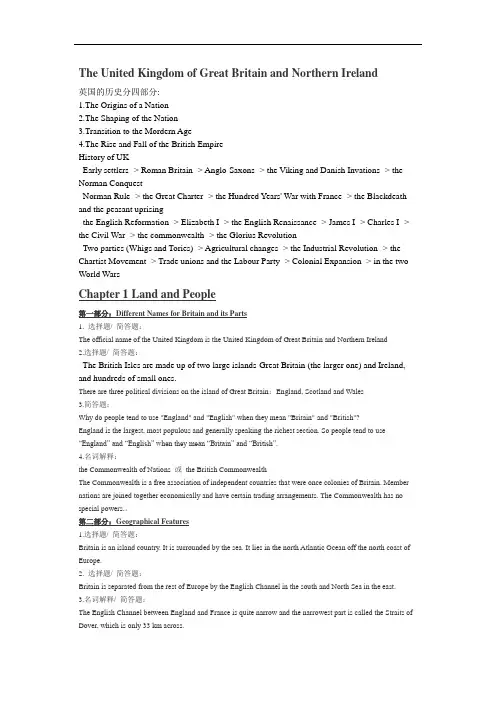
The United Kingdom of Great Britain and Northern Ireland英国的历史分四部分:1.The Origins of a Nation2.The Shaping of the Nation3.Transition to the Mordern Age4.The Rise and Fall of the British EmpireHistory of UKEarly settlers -> Roman Britain -> Anglo-Saxons -> the Viking and Danish Invations -> the Norman ConquestNorman Rule -> the Great Charter -> the Hundred Years' War with France -> the Blackdeath and the peasant uprisingthe English Reformation -> Elizabeth I -> the English Renaissance -> James I -> Charles I -> the Civil War -> the commonwealth -> the Glorius RevolutionTwo parties (Whigs and Tories) -> Agricultural changes -> the Industrial Revolution -> the Chartist Movement -> Trade unions and the Labour Party -> Colonial Expansion -> in the two World WarsChapter 1 Land and People第一部分:Different Names for Britain and its Parts1. 选择题/ 简答题:The official name of the United Kingdom is the United Kingdom of Great Britain and Northern Ireland2.选择题/ 简答题:The British Isles are made up of two large islands-Great Britain (the larger one) and Ireland, and hundreds of small ones.There are three political divisions on the island of Great Britain:England, Scotland and Wales3.简答题:Why do people tend to use "England" and "English" when they mean "Britain" and "British"?England is the largest, most populous and generally speaking the richest section. So people tend to use “England” and “English” when they mean “Britain” and “British”.4.名词解释:the Commonwealth of Nations 或the British CommonwealthThe Commonwealth is a free association of independent countries that were once colonies of Britain. Member nations are joined together economically and have certain trading arrangements. The Commonwealth has no special powers.。
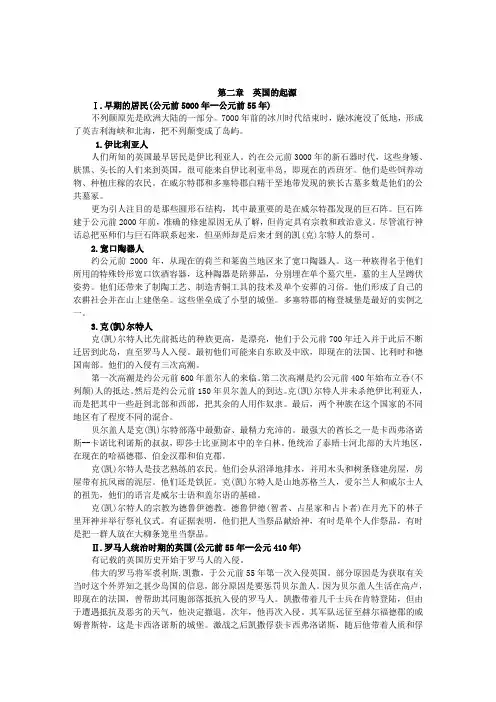
第二章英国的起源Ⅰ.早期的居民(公元前5000年--公元前55年)不列颠原先是欧洲大陆的一部分。
7000年前的冰川时代结束时,融冰淹没了低地,形成了英吉利海峡和北海,把不列颠变成了岛屿。
1.伊比利亚人人们所知的英国最早居民是伊比利亚人。
约在公元前3000年的新石器时代,这些身矮、肤黑、头长的人们来到英国,很可能来自伊比利亚半岛,即现在的西班牙。
他们是些饲养动物、种植庄稼的农民。
在威尔特郡和多塞特郡白精干垩地带发现的狭长古墓多数是他们的公共墓冢。
更为引人注目的是那些圆形石结构,其中最重要的是在威尔特郡发现的巨石阵。
巨石阵建于公元前2000年前,准确的修建原因无从了解,但肯定具有宗教和政治意义。
尽管流行神话总把巫师们与巨石阵联系起来,但巫师却是后来才到的凯(克)尔特人的祭司。
2.宽口陶器人约公元前2000年,从现在的荷兰和莱茵兰地区来了宽口陶器人。
这一种族得名于他们所用的特殊铃形宽口饮酒容器,这种陶器是陪葬品,分别埋在单个墓穴里,墓的主人呈蹲伏姿势。
他们还带来了制陶工艺、制造青铜工具的技术及单个安葬的习俗。
他们形成了自己的农耕社会并在山上建堡垒。
这些堡垒成了小型的城堡。
多塞特郡的梅登城堡是最好的实例之一。
3.克(凯)尔特人克(凯)尔特人比先前抵达的种族更高,是漂亮,他们于公元前700年迁入并于此后不断迁居到此岛,直至罗马人入侵。
最初他们可能来自东欧及中欧,即现在的法国、比利时和德国南部。
他们的入侵有三次高潮。
第一次高潮是约公元前600年盖尔人的来临。
第二次高潮是约公元前400年始布立吞(不列颠)人的抵达。
然后是约公元前150年贝尔盖人的到达。
克(凯)尔特人并未杀绝伊比利亚人,而是把其中一些赶到北部和西部,把其余的人用作奴隶。
最后,两个种族在这个国家的不同地区有了程度不同的混合。
贝尔盖人是克(凯)尔特部落中最勤奋、最精力充沛的。
最强大的酋长之一是卡西弗洛诺斯--卡诺比利诺斯的叔叔,即莎士比亚剧本中的辛白林。
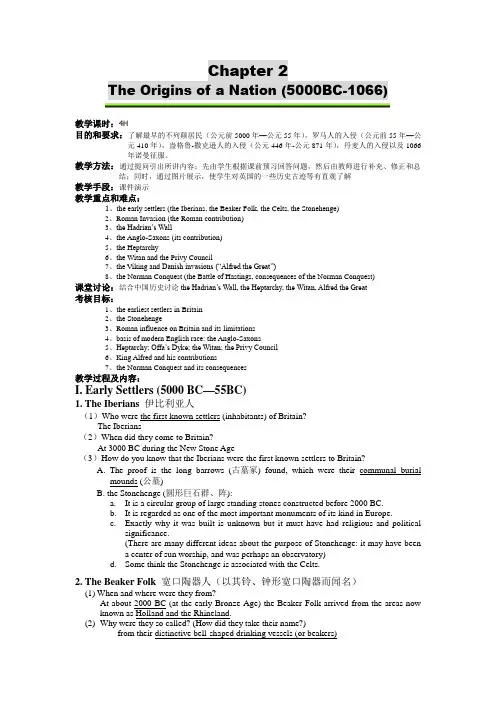
Chapter 2The Origins of a Nation (5000BC-1066)教学课时:4H目的和要求:了解最早的不列颠居民(公元前5000年—公元55年),罗马人的入侵(公元前55年—公元410年),盎格鲁-撒克逊人的入侵(公元446年-公元871年),丹麦人的入侵以及1066年诺曼征服。
教学方法:通过提问引出所讲内容;先由学生根据课前预习回答问题,然后由教师进行补充、修正和总结;同时,通过图片展示,使学生对英国的一些历史古迹等有直观了解教学手段:课件演示教学重点和难点:1、the early settlers (the Iberians, the Beaker Folk, the Celts, the Stonehenge)2、Roman Invasion (the Roman contribution)3、the Hadrian‟s Wall4、the Anglo-Saxons (its contribution)5、the Heptarchy6、the Witan and the Privy Council7、the V iking and Danish invasions (“Alfred the Great”)8、the Norman Conquest (the Battle of Hastings, consequences of the Norman Conquest)课堂讨论:结合中国历史讨论the Hadrian‟s Wall, the Heptarchy, the Witan, Alfred the Great考核目标:1、the earliest settlers in Britain2、the Stonehenge3、Roman influence on Britain and its limitations4、basis of modern English race: the Anglo-Saxons5、Heptarchy; Offa‟s Dyke; the Witan; the Privy Council6、King Alfred and his contributions7、the Norman Conquest and its consequences教学过程及内容:I. Early Settlers (5000 BC—55BC)1. The Iberians伊比利亚人(1)Who were the first known settlers (inhabitants) of Britain?The Iberians(2)When did they come to Britain?At 3000 BC during the New Stone Age(3)How do you know that the Iberians were the first known settlers to Britain?A. The proof is the long barrows (古墓冢) found, which were their communal burialmounds (公墓)B. the Stonehenge (圆形巨石群、阵):a.It is a circular group of large standing stones constructed before 2000 BC.b.It is regarded as one of the most important monuments of its kind in Europe.c.Exactly why it was built is unknown but it must have had religious and politicalsignificance.(There are many different ideas about the purpose of Stonehenge: it may have beena center of sun worship, and was perhaps an observatory)d.Some think the Stonehenge is associated with the Celts.2. The Beaker Folk宽口陶器人(以其铃、钟形宽口陶器而闻名)(1) When and where were they from?At about 2000 BC (at the early Bronze Age) the Beaker Folk arrived from the areas now known as Holland and the Rhineland.(2)Why were they so called? (How did they take their name?)from their distinctive bell-shaped drinking vessels (or beakers)(3)How about their civilization? (What did they bring with them?)a)The art of pottery makingb)The ability to fashion (ornament with patterns) bronze toolsc)The custom of individual buriald)The hill forts (堡垒) and small fortified towns (筑堡城镇). The Maiden Castle is oneof the finest examples.3. The Celts(1) Who were the ancestors of the Scots, Welsh and Irish?The Celts were the ancestors of the Scots, Welsh and Irish(2) When and where were they from?They began to arrive about 700 BC, and may have come from eastern and central Europe, now France, Belgium and Germany(3) What were these people?A.They were Practised farmers. They drained much of the marshlands and built houses ofwood and wickerwork with a weatherproof coating of mud.(带有抗风化的泥层)B.They were ironworkers.(4) What was their religion?Druidism(德鲁伊德教),the Druids—the wise men, astrologers, soothsayers(占卜者)II. Roman Britain (55BC—410AD)1. What do you know about the Roman invasion of Britain?(1)British recorded history begins with the Roman invasion.(2)In 55 BC, the great Roman general Julius Caesar invaded Britain for the first time(partly to gather information about the island and partly to punish the Belgae who helped in fighting against the conquering Roman)the invasion was unsuccessful because of resistance, the successful invasion did not take place until nearly a century(3)In AD 43, Emperor Claudius invaded successfully(4)For nearly 400 years Britain was under the Roman occupation, but it was never a totaloccupation.First, as a result of resistance; Secondly, Roman troops were often withdrawn fromBritain to fight in other parts of the Roman Empire.2. the Hadrian’s W all哈德良长城(公元2世纪,罗马皇帝哈德良下令修建的城墙,用于防御英格兰北部边境,抵抗克尔特部落的进攻)It was one of the two great walls built by the Romans to keep the Picts out of the area they had occupied and conquered.(1)After the Roman occupation, the Romans met with fierce resistance and attacks from thetribes of Scotland. These people were called Picts(皮克特人)because of their “paintedfaces”. )(2)The Romans realized that they could not conquer them. So they withdrew from the north,and built two great walls, the Hadrian‟s Wall and the Antonine Wall, to resist the attacks) 3. the Roman contribution(1) they built a network of towns on their military camps with the capital of London(the suffix –caster or –chester in English place names—Lancaster, Winchester—derives from castra, the Latin word for camp.)(2) the Romans constructed a network of major and secondary roads. From London, roadsradiated all over the country.(3) The Romans made good use of Britain‟s natural resources. They built baths, temples,amphitheatres and beautiful villas.(4)The Romans also brought the new religion, Christianity, to Britain.4. Why was the Roman influence on Britain so limited?Although Britain became part of the Roman Empire, the Roman impact upon the Britons was surprisingly limited as a result of(1)the Romans always treated the Britons as a subject people of slave class.(2)The Romans and the Britons never intermarried during the 4 centuries.(3)The Romans had no impact on the language or culture of ordinary Britons.III. The Anglo-Saxons (446-871) 盎格鲁-萨克逊人1. Who were the Anglo-Saxons?The Anglo-Saxons referred to the three Teutonic tribes(日而漫部落)who invaded Britain in the mid-5th century. They were Jutes, Saxons and Angles.--The Jutes 朱特人, from today‟s Denmark, came to Britain first for assistance to drive out the Picts and Scots.--Then the Saxons from northern German--The Angles who also came from northern German and were to give their name to the English people.2. How did the Heptarchy (七王国) come into being?During the Anglo-Saxon invasion, the three tribes named the Jutes, the Saxons and the Angles settled in different parts of Britain which was divided into many kingdoms. Among them, there were 7 principle kingdoms of Kent, Essex, Sussex, Wessex, East Anglia, Mercia and Northumbria. So they have been given the name of Heptarchy.3. Offa’s Dyke欧发大堤(古代英格兰的巨大土方工程。

从第一世纪开始英国的起源英语作文The origin of England can be traced back to the first century, when the Romans invaded the British Isles and established the province of Britannia. This marked the beginning of the influence of Roman culture and language in the region.After the fall of the Roman Empire, England was invaded by various Germanic tribes, including the Angles, Saxons, and Jutes. These tribes eventually formed the Kingdom of England, with the Anglo-Saxons as its dominant ethnic group. This period saw the emergence of Old English, a Germanic language that would later evolve into what we now know as English.In 1066, the Norman Conquest brought about significant changes to England. William the Conqueror, a Norman noble, successfully invaded England and became its king. Thisevent had a profound impact on the English language, as it introduced a large number of French words into the language. This marked the beginning of Middle English, which combined the Germanic roots of Old English with the French influence of the Normans.Over the centuries, English continued to evolve, absorbing words from Latin, Greek, and other languages through trade, exploration, and cultural exchange. The Renaissance period saw a renewed interest in classical languages and literature, leading to the adoption of many Latin and Greek words into English.The 17th century witnessed the standardization of English grammar and spelling, thanks in part to the publication of the King James Bible and the works of influential writers such as William Shakespeare. This period also saw the establishment of English colonies in North America, Africa, and Asia, leading to further linguistic diversity and the spread of English as a global language.In summary, the origin of England and the English language can be traced back to the first century, with influences from Roman, Germanic, French, and other languages contributing to its development. The evolution of English reflects the rich history and cultural diversity of England and its people.英国的起源可以追溯到公元一世纪,当时罗马人入侵不列颠群岛,并建立了不列颠尼亚省。
从第一世纪开始英国的起源英语作文The origins of the English language can be traced backto the early first century, when the Romans invaded the British Isles and brought Latin with them. Latin was the language of the Roman Empire, and it had a significant influence on the development of the English language.As the Roman Empire began to decline, Germanic tribes such as the Angles, Saxons, and Jutes invaded Britain and brought their own languages with them. These Germanic languages eventually merged with Latin to form what is known as Old English.Over the centuries, Old English continued to evolve and change due to various influences, including the Viking invasions in the 8th and 9th centuries. The Vikings brought their own language, Old Norse, which had a significant impact on the English language, introducing new words and grammatical structures.The Norman Conquest in 1066 also had a major impact on the English language. The Normans, who spoke a dialect of Old French, became the ruling class in England andintroduced many French words into the English language. This period marked the beginning of Middle English, which was a blend of Old English and Old French.By the end of the 14th century, the English language had evolved into what is now known as Modern English. The invention of the printing press by William Caxton in the15th century played a crucial role in standardizing the English language and making it more accessible to the masses.Today, English is one of the most widely spoken languages in the world, with over 1.5 billion speakers worldwide. It has become the global language of communication, business, and diplomacy, and continues to evolve and adapt to the changing needs of its speakers.英语语言的起源可以追溯到公元一世纪早期,当时罗马人入侵不列颠群岛并带来了拉丁语。
英国的起源英文作文英文:The origin of the United Kingdom is a complex and multifaceted topic. It involves the merging of several different kingdoms and the evolution of their cultures and languages over time. The earliest known inhabitants of the British Isles were the Celts, who migrated from mainland Europe around 500 BC. They were followed by the Romans, who established a presence in Britain from 43 AD until their withdrawal in 410 AD.After the fall of the Roman Empire, Britain was invaded by various Germanic tribes, including the Angles, Saxons, and Jutes. These tribes eventually formed the Anglo-Saxon kingdoms, which were united under the rule of King Alfred the Great in the 9th century. The Anglo-Saxon period was characterized by the development of the English language and the spread of Christianity.In 1066, William the Conqueror invaded England from Normandy and established Norman rule over the country. The Normans brought with them a new language, French, which was spoken by the ruling class for several centuries. However, English remained the language of the common people and eventually became the dominant language of the country.Over the centuries, the various kingdoms of England, Scotland, Wales, and Ireland were united through conquest, marriage, and political negotiation. The Acts of Union in 1707 and 1801 formalized the union of England, Scotland, and Wales, while Northern Ireland was added to the United Kingdom in 1921.In modern times, the United Kingdom is a diverse and multicultural country, with a rich history and a vibrant cultural scene. Its people are known for their resilience, their sense of humor, and their love of tea.中文:英国的起源是一个复杂而多面的话题。
Chapter 2The Origins of a Nation (5000 BC – AD 1066)一、本章知识点1.重点:① Arrival and settlement of the Celts② Basis of modern English race: the Anglo-Saxons③ Roman Britain (55 BC – AD 410)④ The Viking and Danish invasions(北欧海盗和丹麦人的入侵)⑤ King Alfred and his contributions(啊弗雷德国王和他的贡献)⑥ The Norman Conquest and its consequences(诺曼征服及其影响)2.难点、考点:① the Anglo-Saxons: Heptarchy; foundation of the English state② King Alfred③ Norman Conquest二、课本内容(一)Arrival and settlement of the Celts (p.17)1. began to arrive about 700 BC2. originally have come from eastern and central Europe, now France, Belgium and southern Germany3. three main waves——1st. Gaels, about 600 BC;2nd. Brythons, 400 BC, (Britain);3rd. Belgae, 150 BC, (Belgium).Gaelic:盖尔语4. The Celtic tribes are ancestors of Highland Scots, the Irish and the Welsh, and their languages are the basis of both Welsh and Gaelic.5. religion: DruidismThe Celts’ religion was Druidism. The Druids worshipped and performed their rites in woods by the light of the moon.(二)Roman Britain1. British recorded history begins with the Roman invasion (55 BC – AD 410).2. Julius Caesar, 55 BC3. under the Roman occupation for nearly 400 years, but never a total occupation4. Boadicea, or Boudicca, queen of the Iceni of East Anglia5. Londinium, capital of the Romans6. Hadr ian’s Wall and the Antonine Wall7. Christianity8. The Roman impact upon the Britons surprisingly limited.(三)Basis of modern English race: the Anglo-Saxons (p.20-23)1. mid-5th century, three Teutonic tribes: Jutes (from southern Denmark), Saxons, and Angles (both from northern Germany); Angles were to give their name to the English people.2. Heptarchy——seven principal kingdoms set up by the Anglo-Saxons: Kent, Essex, Sussex, Wessex, East Anglia, Mercia and Northumbria. (英国版的战国七雄)Monarchy:君主制The Anglo-Saxon tribes were constantly at war with one another, each trying to get the upper hand, so that the kingdoms were often broken up and often pieced together again.3. In 829, Egbert became an overlord of all the English.4. Teutonic religion: Tiu—war, Woden—heaven, Thor—Storms, Freya—Peace5. St. Augustine——the first Archbishop of Canterbury.6. Anglo-Saxons laid the foundations of the English state: divide the country into shires (郡), later counties; the narrow-strip, three-field farming system(三田轮作); manorial system; Witan(议会)(council or meeting of the wisemen, 贤人会议), the basis of the Privy Council which still exists today.(四)The Viking and Danish invasions (p.23-24)1. from the end of 8th century, Norwegian Vikings and Danes from Denmark2. T he Danes gained the “Danelaw”(丹麦法区), the north and east of England.3. The Witan chose Canute, the Danish Leader, as king in 1016. Canute made England part ofa Scandinavian empire.(五)King Alfred and his contributions1. King of Wessex (871-899)(抗击北欧海盗入侵的国家英雄)2. his contributions: “the father of the British navy”; reorganized the fyrd (the Saxonarmy); translated into English Bede’s Ecclesiastical History of the English People; established schools and formulated a legal system3. “Alfred the Great”(六)The Norman Conquest and its consequences (p.24-25)1. King Edward, known as “the Confessor”, was far more Nor man than Saxon2. 4 men laid claim to the English throne: the King of Norway, the Duke of Normandy, Tostig and Harold (two brothers of Edward’s Queen)3. Oct. 14, 1066, Hastings, Anglo-Saxon England perished with Harold’s death.4. William was crowned King of England on Christmas Day.5. the best-known event in English history6. William the Conqueror7. the feudal system was completely established.三、总结历史上定居和入侵英国的不同民族:Celts, Romans, Anglo-Saxons, Viking/Dales, and Normans。
英国人的祖先是哪个民族?英国由四个部分组成,即英格兰、苏格兰、威尔士和北爱尔兰,各自拥有不同的种族起源。
英格兰人,又称英吉利人,是英国英格兰地区的原住民族,母语是英语。
从种族角度来看,英格兰人被认为是盎格鲁-撒克逊人(Anglo-Saxon)的后裔,是日耳曼人的一支,属欧罗巴人种,大多为大西洋波罗的海类型,特征是金发碧眼。
另外,也有历史资料称英格兰人是在长期历史发展过程中由克尔特部落群的不列颠人和日耳曼部落群的盎格鲁人、撒克逊人等结合而成。
他们在超过千年前被古英语称作“Anglecynn”时已有高度的身份认同。
苏格兰人是西欧英国的民族之一,也是苏格兰当地的土著民族。
主要分布在大不列颠岛北部的苏格兰(占当地人口92%),并散布在英国各地。
据悉,苏格兰境内人口近500万,但全世界另有5000万人拥有苏格兰血统。
现代苏格兰人的祖先,主要是公元前1000年左右从欧洲大陆迁徙而来的皮克特人和后来逃到不列颠的克尔特人,还有一部分是欧洲的日耳曼人。
皮克特人,克尔特人和日耳曼人经过长期的融合,终于形成了苏格兰民族的主体。
威尔士人由公元初就住在当地的金姆里人和不列颠人形成,二者均为来自欧洲大陆的克尔特部落群。
罗马统治时期,接受了基督教。
公元5~6世纪盎格鲁人、撒克逊人等日耳曼部落来到后,被排挤到从维河到底河一线,在与盎格鲁—撒克逊人的斗争中逐渐联合,于10世纪中叶至11世纪一度建立统一国家。
13世纪起为盎格鲁—撒克逊人所征服。
爱尔兰人的先民主要是属于爱尔兰人部落群的爱尔兰人,并吸收有英格兰人、诺曼人、苏格兰人的成分。
广义的爱尔兰人属于凯尔特(Celtic)人种,所以北部的北爱尔兰也是凯尔特人。
总而言之,现在大部分的英格兰人(包括威尔士地区的人)都是盎格鲁-撒克逊人的后裔,而苏格兰人和北爱尔兰人的祖先是凯尔特人。
英国人的祖先是怎么来的?英国人是盎格鲁-撒克逊人,他们并不是英伦三岛的原住民。
大约早在公元前一千多年的时候,英伦三岛的原住民凯尔特人已经进入了农耕时代。
但凯尔特人并不是统一的政体,他们分为不同的部族,每个部落都有各自的酋长,或者说王,语言习俗也不一样。
1世纪时,罗马人进驻了英伦三岛,他们至少发现了28个不同的凯尔特部族。
凯尔特人部落酋长的来源并不相同,有的是世袭继承,有的则是通过长老们选举产生,还有两个部族酋长联合执政的情况。
总体而言,其文明形态还处于萌芽阶段。
最先进入英伦三岛的罗马人是凯撒。
公元前55年54年,凯撒率领罗马军队两次进入了不列颠岛。
当时凯撒正在发动高卢战争,而不列颠是支持高卢人抵抗的中心。
在凯撒看来,必须打击英伦三岛的凯尔特人,对他们征讨以示惩戒,对高卢的占领才有把握。
凯撒领导的罗马军队虽然两次渡海进入不列颠南部,但并没有产生继续征服的念头,而是匆匆撤回欧洲大陆,放弃了对这些小岛的继续占领。
直到公元43年,罗马军队才真正开始了对英伦三岛的占领,大不列颠遂成为罗马帝国的一个行省。
罗马人在伦敦修建了码头和兵站,然后逐步向岛屿的内陆扩展。
他们花了30多年的时间,先后征服了英格兰和威尔士。
罗马人在不列颠一待就是将近400年,也给这里带来了不少变化。
岛上原来没有像样的城市,罗马人修筑了四通八达的大道,也建设起许多城市,伦敦就是那个时期发展起来的。
在罗马占领期间,英伦三岛许多城市都是按罗马城市的标准样式建立,街道横平竖直,像棋盘的方格子,便于居民居住。
城内不但有公共浴室,还有集中供暖设施和下水道。
各城市之间则建有别墅乡间住宅,让罗马贵族和和不列颠本地人居住。
但到了公元4世纪初,许多“蛮族”进入了罗马边境,西罗马帝国岌岌可危,不得不在公元407年时,撤回了在英伦三岛驻扎的军团,以保卫随时会被“蛮族”攻陷的罗马城。
不久之后,北方的两个凯尔特部族发现不列颠已经没有罗马军队防守,便开始大举进犯伦敦。